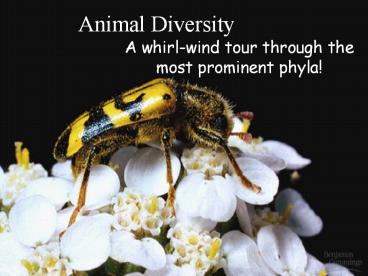Animal Diversity PowerPoint PPT Presentation
Title: Animal Diversity
1
Animal Diversity
- A whirl-wind tour through the most prominent
phyla!
2
Traditional Animal Phylogentic Tree
Which animals have a body cavity? What are the
possible functions of a body cavity in animals?
3
Animal Phylogeny Modern
- Based on sequences in ribosomal RNA (molecular
systematics) - Acoelomate flatworms lost their coelom
- Coelom development happened early
- Combine phyla with lophophore and trocophore
larvae - Combine phyla
- that molt (ecdysis)
Fig 32.8
4
Radiata
X
X
X
X
X
X
- cnidocytes, unique in the animal kingdom
- extracellular digestion in a gastrovascular
cavity allow food larger than individual cells. - Describe the function of a gastrovascular cavity.
Tissues allow for different cells to take
different roles
5
Plylum Cnidaria cnidarians
- detect and respond to stimuli from any direction
- muscles and simple nerve net
- tissue-grade level of organization
Fig 33.6
Fig. 33.5
6
Polyp vs. medusa
Fig. 33.4
- 2 tissue layers
- skin (epidermis)
- gastrovascular cavity lining
- 2 body forms
- polyp
- medusa
Which body form is involved in sexual
reproduction, and why?
Fig 33.4
7
Phylum Platyhelminthes flat worms
- first phyum with organ-system level of
organization, and bilateral symmetry with some
cephalization - gastrovascular cavity secrete mucus and move by
means of cilia and wave-like muscle contractions - A thin body between dorsal and ventral surfaces
- NO coelom (acoelomate)
Flatworms, trematodes, tapeworms
8
Phylum Nemertea - ribbon worms
- Actually acoelomate, but some similarities to the
protostomes - Complete digestive tract closed circulatory
system
What are the advantages of a complete digestive
tract? of a closed circulatory system? What does
this predict about size?
Photo from http//www.seaslugforum.net/factsheet.
cfm?basenemertea
9
Phylum Mollusca mollusks
- Over 150,000 spp mostly marine
- Complete digestive tract most have an open
circulatory system - Soft body protected in most by a hard internal or
external shell made of calcium carbonate
What other organisms manufacture CaCO3?
Bivalves clams, etc.
Gastropods snails, slugs
and why is this process important to the
biosphere?
Cephalopods squid, etc.
Polyplacophora chitons
10
Mollusk anatomy
- Important consumers
- Filter feeders
- Grazers
- Carnivores
- 3 Main body parts
- Foot
- movement
- Visceral mass
- internal organs
- Mantle
- secretes shell gas exchange
Most use a strap like rasping organ called a
radula to scrape food cephalopods have a beak
11
Phylum Annelida segmented worms
- 15,000 species in 3 classes marine, freshwater
and damp soil - Body some organs segmented (division of labor
with regional specializations) - Polychaetes, earthworms leeches
How do these worms exchange gasses?
Fig 33.24bcd
12
Segmented worm anatomy
- Front segments contain sense organs and a
well-developed brain - Complete digestive system and closed circulatory
system - Complex movement
- Circular muscles
- Longitudinal muscles
- Segmental hydrostatic skeleton
- Setae
13
Summary
- Important evolutionary trends in body plan
- Multicellularity Porifera
- True tissues Cnidaria
- Bilateral symmetry Platyhelminthes
- Coelom Mollusca (reduced or absent in some)
- Segmentation Mollusca (some), Annelida
- These trends helped animals adapt to different
environments or exploit the same environment in a
different manner
14
Exoskeletons
- must molt to grow (ecdysis)
Grasshopper molting
Fig 32.8
15
Phylum Nematoda round worms
- gt 90,000 spp, in aquatic habitats, wet soils,
many as decomposers or parasites inside plants
and animals - Tough, transparent cuticle (mostly collagen)
- Cylindrical body longitudinal muscle only
pseudocoelom - Complete digestive tract
Fig 33.25 a, b
Trichinella
Muscle cells
16
Phylum Arthropoda arthropods
- Jointed appendages (jointed feet)
- gt 1 million spp, most of them insects (beetles)
- Most diverse, widely distributed abundant of
all the animal phyla - Hard exoskeleton of chitin
- Relatively impermeable to water
- Strong protection muscle attachment (striated
muscle) - Non-living
What problems does a tough, waterproof
exoskeleton create?
Fig 33.32
17
Arthropod anatomy
- Extensive cephalization
- Well developed sense organs sight, taste
- Segmentation
- some fused and modified into specialized regions
(great diversification of form and function)
- Basic Body Plan
- head
- thorax
- abdomen
Fig 33.26 Lobster crustacean
18
Class Insecta - Insects
- Most successful phylum
- Mostly terrestrial, but often requiring water for
reproduction - Only invertebrates with adaptations for flight
Fig 33.33
For what purpose(s)?
Fig 33.32
Fig 33.34
19
Class Arachnida spiders, mites, ticks, scorpions
- Mostly terrestrial
- Cephalothorax (fused region)
- 6 pairs of appendages
- 2 pairs for feeding
- 4 pairs of walking legs
Fig 33.30b
20
Scorpions mites
Parasitic mites in honey bee air tube
cf Fig 33.29
Scorpion in defensive posture
21
Class Crustacea crabs, shrimp, barnacles
- mostly marine
- specialized appendages
- carnivores, detritivores, filter feeders
Barnacles
Lobster
How do these mostly aquatic organisms exchange O2
and CO2?
Shrimp
22
Deuterostomes
Protostomes
Fig 32.7
23
Phylum Echinodermata echinoderms
- 7,000 spp, all marine
- spiny skin
- radial symmetry in adults (larvae bilateral)
- Endoskeleton
- plates and projecting elements
- functions like an exoskeleton
- Water vascular system
sea stars
Brittle stars
Sea cucumbers
How does this relate to lifestyle in adults vs.
larvae?
Sea urchins
crinoids
Fig 33.37
24
Water vascular system
- Unique
- Fluid-filled tubes
- begin in the madreporite
- end in tube feet
- Tube feet
- locomotion
- food gathering
- gas exchange
Fig 33.38

